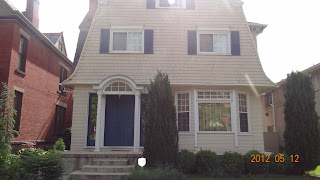The revitalization of the area is a much needed project for
what is known as one of the oldest areas. As the area continues to redevelop
through investment buys, it is my belief that the importance of partnerships of
older residents serves key in preventing the eyebrow raising term “gentrification”.
OTENA (Olde Towne East Neighborhood Association), has
actively begun the process of making a safer and friendlier community for all
residents and visitors. Thereby giving a more welcoming environment to
individuals that may tour the area as did we.
Like all things this area is going through a cyclical
process, that in these times could bring different results if handled to quickly
and without a well thought out strategy. In my opinion, over the next 5-10
years, beautification of this area will once again take precedence while trying
to regain attraction to the downtown area.
Lauren: I think both of these neighborhoods have a lot of potential to be vibrant and diverse as long as the restrictions on property regulations stay fairly loose. Olde Towne East's neighborhood association leaves a lot up for owners to decide how they develop their property, from paint colors and facade work to yard decisions. Mayor Coleman has not chosen to let this neighborhood be identified as historic (although it is very much), and as long as it stays that way, the home and rent prices in some parts of the neighborhood can stay fairly low.
This area has a sense of place to me because of its large landmark "anchor," the Franklin Park Conservatory. From here, other shops, galleries, and restaurants are popping up that will stay in the neighborhood because of the loyalty by residents, and the marketing by well known Columbus newspapers.
There are still some unsafe areas of OTE and Franklin Park, but overall I think it would make an excellent place to live. Bus lines stop throughout both neighborhoods, and it is a great link between Bexley and downtown. It has more of an informal and laid back feel compared to the manicured and formal attitudes of the former.
Will: Knowing the history of these neighborhoods I believe this neighborhood could even out in terms of housing values and diversity, but it would take some grass roots planning. I loved the fact that in our interviews people knew each other, looked out for each other, and have been there long term. One of the people we interviewed told us they just stay out of the crime but call the police if they see questionable activity. That says a lot about a neighborhood.
The place is beautiful on one street and ugly on the next, it is like night and day over and over. This actually can be positive because with so much vacancy and dilapidation the investment is low therefore the rent can stay affordable and won't displace current residents. There is much investment going in and around the neighborhoods so in reality things are looking up, only time will tell. Some things going in are new transit centers, neighborhood health centers, and affordable retail. This benefits much of the lower income population. Overall I think the neighborhood is headed in the right direction.
Location, location, location. That's what its all about. These neighborhoods have the location and the amenities for public services are being reestablished. I believe there is good opportunity to improve the housing while still keeping it affordable for current residents and the current high value places will also benefit. I like this neighborhood and have learned a lot in the fieldwork we have done.

























